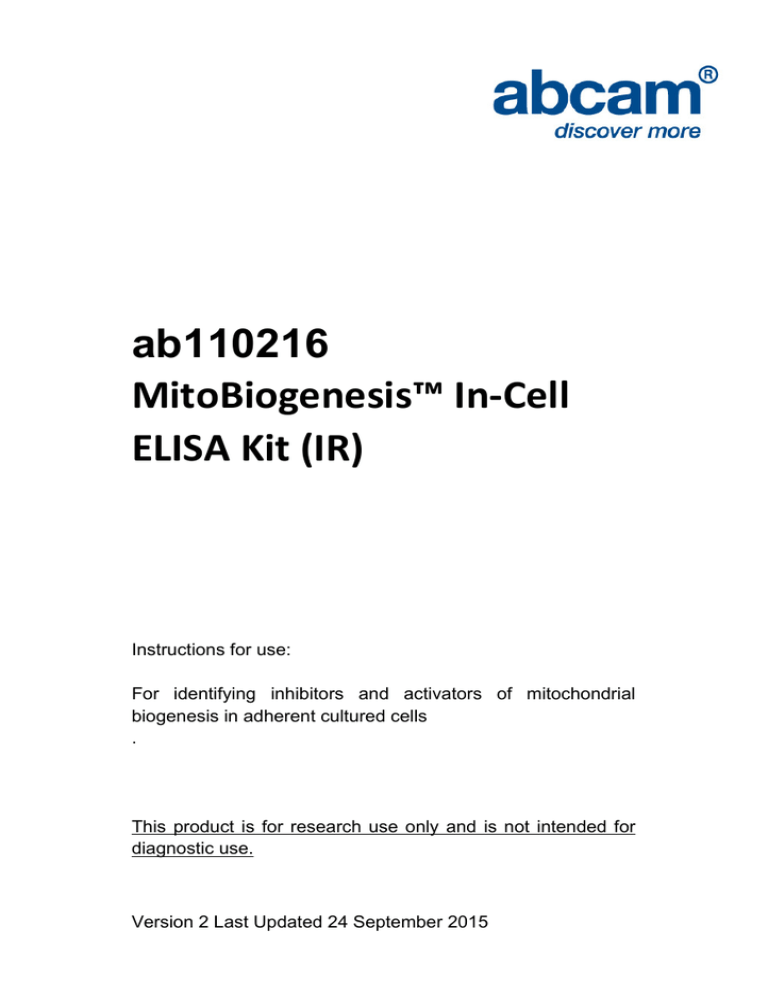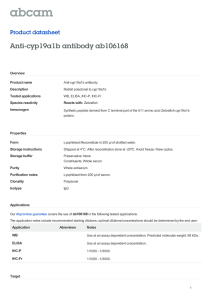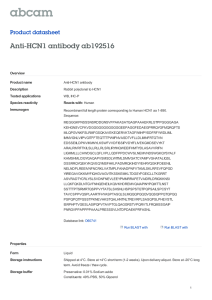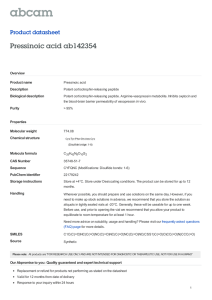ab110216 MitoBiogenesis™ In-Cell ELISA Kit (IR)
advertisement

ab110216 MitoBiogenesis™ In-Cell ELISA Kit (IR) Instructions for use: For identifying inhibitors and activators of mitochondrial biogenesis in adherent cultured cells . This product is for research use only and is not intended for diagnostic use. Version 2 Last Updated 24 September 2015 Table of Contents INTRODUCTION 1 1. BACKGROUND 1 2. ASSAY SUMMARY 2 GENERAL INFORMATION 3 3. PRECAUTIONS 3 4. STORAGE AND STABILITY 3 5. LIMITATIONS 3 6. MATERIALS SUPPLIED 4 7. MATERIALS REQUIERED, NOT SUPPLIED 4 8. TECHNICAL HINTS 5 ASSAY PREPARATION 6 9. REAGENT PREPARATION 6 ASSAY PROCEDURE 7 10. 7 ASSAY PROCEDURE DATA ANALYSIS 10 11. TYPICAL DATA 10 12. SPECIFICITY 14 RESOURCES 15 13. TROUBLESHOOTING 15 14. APPENDIX 16 15. NOTES 17 INTRODUCTION INTRODUCTION 1. BACKGROUND For identifying inhibitors and activators of mitochondrial biogenesis in adherent cultured cells. Each kit contains sufficient reagents to analyze two 96-well plates of fixed human, rat, mouse, or bovine cells. This kit utilizes IRDyes® for detection, and so requires a LI-COR® Odyssey® or Aerius® imaging system. An alternate colorimetric version of this kit is available for use with standard plate readers - MitoBiogenesis™ In-Cell ELISA Kit (Colorimetric) (ab110217/MS643). In-Cell ELISA IR Kits use quantitative immunocytochemistry to measure protein levels or post-translational modifications in cultured cells. Cells are fixed in a 96-well plate and targets of interest are detected with highlyspecific, well-characterized monoclonal antibodies, and levels are quantified with IRDye®-labeled Secondary Antibodies. IR imaging and quantitation is performed using a LI-COR® Odyssey® or Aerius® system. ab110215 (MS642) is designed to measure drug-induced effects on mitochondrial biogenesis early in the safety screening process. The ICE™ Kit is a true duplexing 96/384-well assay that ratios both an mtDNA- and an nDNA-encoded protein in cultured or primary cells, and which requires very little sample preparation and few overall steps. Cells (human, rat or mouse) are seeded in 96- or 384-well microplates, and after exposure to experimental compounds for several cell doublings, the levels of two mitochondrial proteins are measured simultaneously in each well. The two proteins are each subunits of a different oxidative phosphorylation enzyme complex, one protein being subunit I of Complex IV (COX-I), which is mtDNA-encoded, and the other being the 70 kDa subunit of Complex II (SDH-A), which is nDNA-encoded. Complex IV includes several proteins which are encoded in the mitochondrion, while the proteins of Complex II are entirely encoded in the nucleus. Optionally, total protein levels can also be measured. LI-COR®, Odyssey®, Aerius®, IRDye™ and In-Cell Western™ are registered trademarks or trademarks of LI-COR Biosciences Inc. Discover more at www.abcam.com INTRODUCTION 2. ASSAY SUMMARY Seed cells and incubate overnight. Apply treatment activators or inhibitors. Fix cells with Fixing Solution. Incubate at room temperature. Add Quenching Buffer. Incubate at room temperature. Add Blocking Buffer. Incubate at 37ºC. Add prepared primary antibody to each well used. Incubate at room temperature. Empty and wash each well. Add prepared secondary antibody. Incubate at room temperature. Image plate and analyze data. If desired, stain with Janus Green and measure relative cell seeding density in a microplate spectrophotometer or IR imager. Calculate ratios and perform data analysis. Discover more at www.abcam.com GENERAL INFORMATION GENERAL INFORMATION 3. PRECAUTIONS Please read these instructions carefully prior to beginning the assay. All kit components have been formulated and quality control tested to function successfully as a kit. Modifications to the kit components or procedures may result in loss of performance. 4. STORAGE AND STABILITY Store kit at 4ºC in the dark immediately upon receipt. Kit has a storage time of at least 6 months from receipt, providing components have not been reconstituted. Refer to list of materials supplied for storage conditions of individual components. Observe the storage conditions for individual prepared components in the Materials Supplied section. Aliquot components in working volumes before storing at the recommended temperature. Reconstituted components are stable for 2 months. 5. LIMITATIONS Assay kit intended for research use only. Not for use in diagnostic procedures. Do not mix or substitute reagents or materials from other kit lots or vendors. Kits are QC tested as a set of components and performance cannot be guaranteed if utilized separately or substituted. Discover more at www.abcam.com GENERAL INFORMATION 6. MATERIALS SUPPLIED Item 10X Phosphate Buffered Saline (PBS) 100X Triton X-100 (10% solution) 400X Tween – 20 (20% solution) 10X Blocking Solution 100 mL Storage Condition (Before Preparation) 4°C 500 µL 4°C Room Temperature 2 mL 4°C Room Temperature 15 mL 4°C 200X Primary Antibodies 100 µL 4°C 1000X IRDye®-labeled Secondary Antibody 1 X Janus Green Stain 24 µL 4°C Room Temperature Room Temperature Room Temperature 11 mL 4°C 2 EA 4°C Plate Seals Amount Storage Condition (After Preparation) Room Temperature Room Temperature Room Temperature 7. MATERIALS REQUIERED, NOT SUPPLIED A LI-COR® Odyssey® or Aerius® Infrared imaging system Two 96-well, transparent bottom, flat bottom cell culture plates. Collagen or poly-lysine plates which have black walls and transparent bottom wells are highly recommended for improved cell seeding and data quality. Note – 384-well plates can also be used with minor protocol modifications - please see Appendix for details 20% paraformaldehyde Deionized water Multichannel pipette (recommended) 0.5 M HCl (optional for Janus Green cell staining procedure) Discover more at www.abcam.com GENERAL INFORMATION 8. TECHNICAL HINTS This kit is sold based on number of tests. A ‘test’ simply refers to a single assay well. The number of wells that contain sample, control or standard will vary by product. Review the protocol completely to confirm this kit meets your requirements. Please contact our Technical Support staff with any questions. Selected components in this kit are supplied in surplus amount to account for additional dilutions, evaporation, or instrumentation settings where higher volumes are required. They should be disposed of in accordance with established safety procedures. Keep enzymes, heat labile components and samples on ice during the assay. Make sure all buffers and solutions are at room temperature before starting the experiment. Samples generating values higher than the highest standard should be further diluted in the appropriate sample dilution buffers. Avoid foaming or bubbles when mixing or reconstituting components. Avoid cross contamination of samples or reagents by changing tips between sample, standard and reagent additions. Ensure plates are properly sealed or covered during incubation steps. Make sure you have the right type of plate for your detection method of choice. Make sure the heat block/water bath and microplate reader are switched on before starting the experiment. Discover more at www.abcam.com ASSAY PREPARATION ASSAY PREPARATION 9. REAGENT PREPARATION 9.1. Briefly centrifuge small vials at low speed prior to opening Component Component information 9.2. 1X PBS DilutE 50 mL of 10X PBS in 450 mL deionized water. Mix well. Store at room temperature. 9.3. 1X Wash Buffer Dilute 0.5 mL of 400X Tween-20 in 199.5 mL of 1X PBS. Mix well. Store at room temperature. 9.4. 4% Paraformaldehyde Solution Prepare immediately prior to use by diluting 2.5 mL 20% paraformaldehyde in 10 mL 1X PBS. Note – Paraformaldehyde is toxic and should be prepared and used in a fume hood. Dispose of paraformaldehyde according to local regulations. 9.5. 1X Permeabilization Buffer Prepare immediately prior to use prepare by diluting 0.15 ml 100X Triton X-100 in 14.85 ml 1X PBS. 9.6. 2X Blocking Solution Prepare immediately prior to use by diluting 5 ml 10X Blocking Solution in 20 ml 1X PBS. 9.7. 1X incubation Buffer Prepare immediately prior to use by diluting 2.5 ml 10X Blocking Solution in 22.5 ml 1X PBS. Discover more at www.abcam.com ASSAY PROCEDURE ASSAY PROCEDURE 10. ASSAY PROCEDURE Equilibrate all materials and prepared reagents to correct temperature prior to use. It is recommended to assay all standards, controls and samples in duplicate. Prepare all reagents, working standards, and samples as directed in the previous sections. NOTE: It is recommended to use a plate shaker (~300 rpm) during incubation step. 10.1. Cell seeding density, culture surface treatment needed for optimal attachment, culture medium and growth conditions are cell-type specific and will be defined by your experimental demands. To determine the background signal it is essential to omit primary antibody from at least one well containing cells for each experimental condition. For suggestions and general guidelines, see Appendix. 10.2. In general, ICE analysis is optimal when the final fixed cell density is approximately 20,000 - 50,000 adhered cells per well. 10.3. Verify that cells have adhered to the bottom of the plate. Gently aspirate off medium into a container for proper disposal. Immediately add 4% paraformaldehyde to the wells of the plate. Gently trickle solution down the sides of each well to avoid dislodging cells. Incubate for 20 minutes. 10.4. Gently aspirate the paraformaldehyde solution from the plate and wash 3 times briefly with 300 μL 1X PBS. Finally, add 100 μL of 1X PBS to the wells of the plate. The plate can now be stored at 4°C for several days. Cover the plate with provided seal. Note: The plate should not be allowed to dry at any point during or before the assay. Dispose of paraformaldehyde according to local regulations. Remove PBS and blot plate upside down on a paper towel. 10.5. Remove PBS and blot plate upside down on a paper towel. 10.6. Add 100 μL of freshly prepared 1X Permeabilization Buffer to each well of the plate. Incubate 30 minutes, with gentle shaking. Discover more at www.abcam.com ASSAY PROCEDURE 10.7. Remove 1X Permeabilization Buffer and add 200 μL 2X Blocking Solution to each well of the plate. Incubate 2 hours, with gentle shaking. 10.8. Prepare 1X Primary Antibody Solution by diluting the 200X Primary Antibodies into 1X Incubation Buffer. Use 1 volume of the 200X stock per 199 volumes of 1X Incubation Buffer. 10.9. Remove 2X Blocking Solution and add 100 μL 1X Primary Antibody Solution to each well of the plate. Incubate overnight at 4°C. 10.10.Remove Primary Antibody Solution and wash the plate 3 times briefly with 1X Wash Buffer. For each wash, rinse each well of the plate with 250 μL of 1X Wash Buffer. Do not remove the last wash until step 10.13. 10.11.Prepare 1X Secondary Antibody Solution by diluting 12 μL 1000X IRDye-labeled Secondary Antibody into 12 mL 1X Incubation Buffer. Note – Protect fluorescently labelled antibodies from light. 10.12.Remove the 1X Wash Buffer and add 100 μL 1X Secondary Antibody Solution to each well of the plate. Incubate 1 hour, with gentle shaking. 10.13. Remove Secondary Antibody Solution and wash 4 times briefly with 1X Wash Buffer. For each wash, rinse each well of the plate with 250 μL of 1X Wash Buffer. Do not remove the last wash. 10.14.Wipe the bottom of the plate and the scanner surface with 70% ethanol and scan the plate on the LI-COR® Odyssey® system using both 700 and 800 channel according to manufacturer’s instructions. 10.15.Analyze background-corrected results using LI-COR® ICW software, or other suitable data analysis software, such as Microsoft Excel or GraphPad Prism. Discover more at www.abcam.com ASSAY PROCEDURE Whole Cell Staining with Janus Green (Optional) Note –It is recommended to use a plate shaker (~300 rpm) during incubation steps. 10.16.Remove last 1X Wash and add 50 μL of 1X Janus Green Stain per well. Incubate plate for 5 minutes at room temperature. 10.17.Remove dye, wash plate 5 times in deionized water or until excess dye is removed. 10.18.Remove last water wash, blot to dry, add 100 μL of 0.5 M HCl and incubate for 10 minutes. 10.19.Measure using a LI-COR® Odyssey® scanner in the 700 nm channel or measure OD595 nm in a standard microplate spectrophotometer. 10.20.The IR data can be normalized to the Janus Green staining intensity to account for differences in cell seeding density. Discover more at www.abcam.com DATA ANALYSIS DATA ANALYSIS 11. TYPICAL DATA For statistical reasons, we recommend each sample should be assayed with a minimum of two replicates (duplicates). 11.1. Utility Assay utility can be demonstrated using chloramphenicol, a drug known to disturb mitochondrial biogenesis and specifically reduce levels of mtDNA-encoded proteins. Chloramphenicol also has wellknown mitochondrial toxicity, the mechanism of which is the aforementioned reduction in mtDNA-encoded protein levels, and thus reduced OXPHOS function, through inhibition of mtDNA-encoded protein synthesis on mitochondrial ribosomes, which are structurally similar to bacterial ribosomes. In contrast, protein synthesis of nuclear-DNA-encoded transcripts on cytosolic ribosomes is unaffected by chloramphenicol Figure 1. Inhibition of mitochondrial biogenesis by chloramphenicol. The IC50 of a drug’s effect on mitochondrial protein translation can be determined quickly using the ab110216. In this example, cells were seeded at 3000 cells/well, allowed to grow for 3 cell doublings in a drug dilution series and then the relative amounts of COX-I, and SDH-A were measured in each well. Chloramphenicol inhibits mtDNA-encoded COX-I protein synthesis relative to nuclear DNA-encoded SDH-A protein synthesis by 50% at 3.5 μM. Discover more at www.abcam.com DATA ANALYSIS Reliability In-Cell ELISA results provide accurate quantitative measurements of cellular antigen concentrations. However, In-Cell ELISA does not provide internal confirmation of antibody binding specificity with each experiment, unlike traditional Western blots or immunocytochemistry, which allow confirmation by molecular weight or subcellular localization respectively. Therefore, confidence in antibody specificity is critical to In-Cell ELISA data interpretation and reliability. All of Abcam’s ICE™-qualified antibodies have been screened rigorously for specificity by Western blotting and by fluorescence immunocytochemistry under the conditions used for the ICE. Examples demonstrating the Western blot and immunocytochemical specificities of the two monoclonal antibodies used in the ab110216 are shown in Figures 2a and 2b. Figure 2a. Antibody specificity demonstrated by Western Blot: A Western blot of total cell protein (10 μg) from human or rat cultured cells was probed with the primary and secondary antibodies and scanned with a LI-COR® Odyssey® imager. The two mitochondrial proteins targeted by the two primary mAbs were labeled and visualized specifically despite the presence of thousands of other proteins. Furthermore, reduction of mtDNA levels in human Rho0 (mtDNA-depleted) cells, or inhibition of mitochondrial protein translation by chloramphenicol in rat cells both result in specific reduction of COX-I protein while nuclear DNA-encoded SDH-A is unaffected. Discover more at www.abcam.com DATA ANALYSIS Figure 2b. Antibody specificity demonstrated by immunocytochemistry: Twocolor immunocytochemical labeling of cultured cells with the two ab110216(MS642) primary monoclonal antibodies specific for COX-I and SDH-A. The two antibodies exhibit striking and specific co-localization in the mitochondria, consistent with the known mitochondrial expression of both proteins. Reproducibility Results from the ab110216 (MS642) are highly reproducible, with interassay and intra-assay variability of <5% readily obtainable. Figure 3. Assay reproducibility demonstrated by experiments conducted on three separate days: HepG2 cells were grown for 7 days in the presence of 10 μM chloramphenicol and then measured in duplicate on 3 different days using the ab110216. The assay was able to record inhibition of mitochondrial biogenesis with an average intra-day CV of 2.3% and an average day-to-day CV of 1.9%. Discover more at www.abcam.com DATA ANALYSIS Flexibility ab110216 is reproducible at all cell concentrations within the recommended range. To demonstrate this flexibility, rat H9C2 cardiomyocytes were cultured in Dulbecco’s Modified Eagle’s Medium supplemented with 10% fetal calf serum, with or without 10 μM chloramphenicol. The cells were allowed to divide three times over five days, harvested by trypsinization and then loaded into a 96-well plate at the seeding densities described below. The cells were then assayed using ab110216 including cell staining by Janus Green at the end of the assay. IR-fluorescence was quantitated using a LI-COR® Odyssey® imager. Figure 4a. Quantitative measurement of the COX-I/SDH-A protein expression ratio. At all cell concentrations, a constant ratio of mtDNA-encoded protein expression (COX-I) to nuclear DNA-encoded mitochondrial protein expression (SDH-A) is observed in untreated cells. Therefore, normalizing COX-I levels to SDH-A levels simplifies data analysis and eliminates the need to perform all tests at the same cell concentration. Discover more at www.abcam.com DATA ANALYSIS Figure 4b. Visual representation of inhibition of mtDNA-encoded protein synthesis: Visually-imaged levels of mtDNA-encoded COX-I are shown in the green 800 channel while levels of nuclear DNA-encoded SDH-A are shown in the red 700 channel. The merged image shows the relative ratios of COX-I/SDH-A protein expression in each microwell. Wells with normal levels of both proteins exhibit a yellow merged color due to approximately equal red and green signals. In contrast, wells with low levels of COX-I and normal levels of SDH-A exhibit an orange color due to the relative lack of green (COX-I) fluorescence. The specific inhibition of mtDNA-encoded protein synthesis by chloramphenicol is thus easily observed. 12. Specificity Species Cross-Reactivity: Human, rat, mouse and bovine Discover more at www.abcam.com RESOURCES RESOURCES 13. TROUBLESHOOTING Problem Cause Solution Assay not working Use of ice-cold buffer Plate read at incorrect wavelength Use of a different 96-well plate Buffers must be at room temperature Check the wavelength and filter settings of instrument Sample with erratic readings Samples not deproteinized (if indicated on protocol) Cells/tissue samples not homogenized completely Samples used after multiple free/ thaw cycles Use of old or inappropriately stored samples Presence of interfering substance in the sample Measured at incorrect wavelength Samples contain Unanticipated interfering results substances Sample readings above/ below the linear range Discover more at www.abcam.com Clear plates Use PCA precipitation protocol for deproteinization Use Dounce homogenizer, increase number of strokes Aliquot and freeze samples if needed to use multiple times Use fresh samples or store at - 80°C (after snap freeze in liquid nitrogen) till use Check protocol for interfering substances; deproteinize samples Check equipment and filter setting Troubleshoot if it interferes with the kit Concentrate/ Dilute sample so it is within the linear range RESOURCES 14. APPENDIX Black-walled, clear-bottomed collagen or lysine coated plates are highly recommended to improve data quality, cell adhesion and seeding homogeneity. ICE experiments give robust signal when the cell density is in the range 20,000-50,000 cells / well. Working on the high end of this range will generate stronger signals and allow greater reductions to be measured accurately. It is highly recommended to apply media only, without cells, to several wells to provide a background signal for the experiment which can be subtracted from all measured data. A typical work flow is to seed the cells at low density directly into 96-well microplates and then allow them to divide to the desired cell density. Particular care must be taken when using in-well treatments that cause significant cell toxicity, loss of adhesiveness, apoptotic cell detachment or a decline in the rate of cell division. For this reason this kit takes a ratiometric approach to determine mitochondrial biogenesis. In addition this kit includes a method to determine the relative cell density per well by cell staining using the provided Janus Green Stain. An alternate experimental work flow is to grow cells, both treated and untreated, in large cell culture flasks or dishes, e.g. 15 cm diameter dishes. The cells can then be harvested by trypsinization and should then be counted before seeding into the 96-well plate where they must be allowed to adhere, e.g., 4 hours for fibroblasts. For a 384-well plate format, seed ¼ of the number of cells specified in this protocol. Prepare all solutions and wash buffers as described, but dispense ¼ of the specified volumes into the wells at the relevant steps. For plate scanning, set the intensity to 7 for both the 700 and 800 channels, as long as there is no signal saturation. Dry the plates prior to scanning if more signal intensity is required. Discover more at www.abcam.com RESOURCES 15. NOTES Discover more at www.abcam.com UK, EU and ROW Email: technical@abcam.com | Tel: +44-(0)1223-696000 Austria Email: wissenschaftlicherdienst@abcam.com | Tel: 019-288-259 France Email: supportscientifique@abcam.com | Tel: 01-46-94-62-96 Germany Email: wissenschaftlicherdienst@abcam.com | Tel: 030-896-779-154 Spain Email: soportecientifico@abcam.com | Tel: 911-146-554 Switzerland Email: technical@abcam.com Tel (Deutsch): 0435-016-424 | Tel (Français): 0615-000-530 US and Latin America Email: us.technical@abcam.com | Tel: 888-77-ABCAM (22226) Canada Email: ca.technical@abcam.com | Tel: 877-749-8807 China and Asia Pacific Email: hk.technical@abcam.com | Tel: 108008523689 (中國聯通) Japan Email: technical@abcam.co.jp | Tel: +81-(0)3-6231-0940 www.abcam.com | www.abcam.cn | www.abcam.co.jp Copyright © 2015 Abcam, All Rights Reserved. The Abcam logo is a registered trademark. All information / detail is correct at time of going to print. Discover more at www.abcam.com




![Anti-CD300e antibody [UP-H2] ab188410 Product datasheet Overview Product name](http://s2.studylib.net/store/data/012548866_1-bb17646530f77f7839d58c48de5b1bb7-300x300.png)
